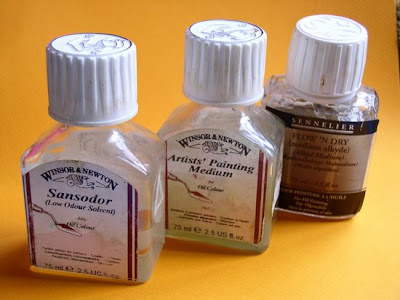Why is this rule important?
The first and foremost reason to paint fat over lean is conservation. If you paint fat first and leaner on top, the different tensions when the paint dries will cause cracks over time. The reason this may happen is that lean paint dries more quickly than fat paint.
Lean paint is the one with less oil or where you have more turpentine than oil. This is the case when you dilute the paint from the tube with some turpentine.
Fat paint has higher oil content. Paints in tubes are mixed with oil. You can make the paint fatter by adding more oil (linseed oil, walnut oil ) or painting mediums.
The first and foremost reason to paint fat over lean is conservation. If you paint fat first and leaner on top, the different tensions when the paint dries will cause cracks over time. The reason this may happen is that lean paint dries more quickly than fat paint.
Lean paint is the one with less oil or where you have more turpentine than oil. This is the case when you dilute the paint from the tube with some turpentine.
Fat paint has higher oil content. Paints in tubes are mixed with oil. You can make the paint fatter by adding more oil (linseed oil, walnut oil ) or painting mediums.

According to the article on “craquelures” published in the Grove Art Dictionary:
“Cracks that originate within the paint layer, often due to poor technique,
are more likely to detract from the painting’s appearance. Reynolds’s use of bituminous pigments provides many examples of ‘craquelure anglaise’. Premature overpainting, especially of thick layers of oil paint, and not painting ‘fat over lean’ are other common causes.
Before being an art, oil painting is a craft and you should master a few rules: “fat over lean” is one.
If you paint alla prima (e.g. in one session, painting over while the paint is still fresh), painting fat over lean becomes even more important because it is also what allows you to continue layering paint without turning your painting into a patch of muddy colours.
If you paint alla prima (e.g. in one session, painting over while the paint is still fresh), painting fat over lean becomes even more important because it is also what allows you to continue layering paint without turning your painting into a patch of muddy colours.
Painting Sequence
Here is a typical way to layer paint following the fat over lean rule:
- Start with highly diluted paint (with a thinner like rectified turpentine or other painting solvent or odourless solvent) to sketch the painting with a wash of oil paint.
- For the next stage, use the paint as it comes out of the tube, or with a little bit of thinner. Paints have different consistencies depending on the colour and you will be able to adjust with experience how much thinner you have to add. You are blocking in, defining your darkest darks and your medium tones. You save the significant light areas, but don’t paint them as light as they should be at the end. The reason for this is contrast: the balance will be achieved over time, by tuning up or down tones and colours.
- For the next stage, you can use linseed oil or a painting medium. There are a number of mediums available from art shops and art supply manufacturers developed different ones. It is worth trying them out until you find the one that suit your style in term of consistency, fluidity and stickiness. I prefer mediums that are thick and sticky so that the paint will be mellow with a “good body” and will stick onto the fresh underpaint.
- By varying the proportion of medium in the paint, you can glaze and apply translucent layers. Glazes form a stable film when they solidify. They should only be done at the end as a glaze will contain a large proportion of medium or resin.
Studio hacks
- Sometime the oil in the tube will separate from the pigments and come at the mouth of the tube. In this case, it may be necessary to use a painting knife to mix the oil back into the pigments in order to obtain the right consistency.
- If a particular colour comes out of the tube saturated with oil and you are at an early stage of the painting that requires lean paint, squeeze the paint onto a sheet of paper or paper towel. The paper will absorb the excess of oil. Then, scrap the paint from the paper with a painting knife and put it on your palette.
If you follow the "fat over lean" principle, your oil paintings will last for generations to come.
Related articleA discussion with Catherine Metzger - Conservator specializing in Flemish and Italian Renaissance Paintings at the National Gallery, Washington, D.C. A detailed article on the fat over lean principle and the difference between thinners and mediums by Sanders-Studio.com.

2 comments:
If you have gotten to the stage of applying the fattest layer - paint and linseed oil mix, and it dries and then you feel it's wrong....how can you remove it? Thank you for any help!
Debra,
I would do one of the following things:
1) wait for the painting to dry and continue from there.
2) Use the tonking method to remove the top layer without scrubbing. I have described this method in another post: Troubleshoot your oil painting with tonking.
I hope this helps.
Post a Comment